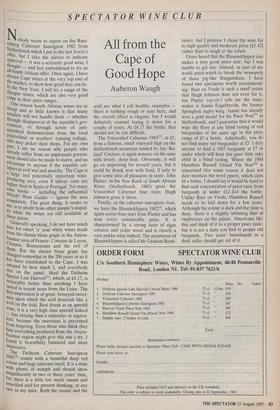SPECTATOR WINE CLUB
All from the Cape of Good Hope
Auberon Waugh
Nobody wrote to report on the Rust- enberg Cabernet Sauvignon 1982 from Stellenbosch which I put in the last Avery's Offer, but I take the silence to indicate approval — it was a seriously good wine, I thought — and feel emboldened to try an all-South African offer. Once again, I have chosen Cape wines at the very top end of the market, to show how good they can be. In the New Year, I will try a range of the cheaper wines, which are also very good value in their price ranges. One reason South African wines are so cheap and so little known is that many retailers will not handle them — whether through disapproval of the republic's gov- ernment, or through terror of anti- apartheid demonstrators from the local Polytechnic or teachers' training college, who may picket their shops. For my own Pan, I see no reason why people who already suffer from an unpleasant govern- ment should also be made to starve, and no ,advantage to anyone if the republic col- lapses in civil war and anarchy. The Cape is a large and potentially important wine- producing area, even if labour costs are higher than in Spain or Portugal. Yet many wine books — including the influential Which? Wine Guides — ignore the area completely. The great thing, it seems to tile, is to profit from other people's stupid- ity while the wines are still available at these prices. Generally speaking, I do not have much time for sweet 'n' sour white wines made from the chenin blanc grape in the Anjou- Saumur area of France: Coteaux de Layon, Chanme, Bonnezeaux and the rest of them. But the chenin blanc grape has changed somewhat in the 200 years or so it has been established in the Cape. I was amazed by how much I, and everybody else on the panel, liked the Delheim Special Late Harvest(i), which, at £4.17, is noticeably better than anything I have tasted in recent years from the Loire. The first impression is of great, honeyed sweet- ness upon which the acid descends like a wolf on the fold. Best drunk as an aperitif wine, it is a very high class aperitif indeed --. less cloying than a sauternes or equiva- lent, because the sweetness is prevented from lingering. Even those who think they hate everything produced from the Anjou- Saumur region might give this one a try. I found it beautifully balanced and most inapressive.
The Delheim Cabernet Sauvignon 1985(2) comes with a beautiful deep red colour and huge cabernet smell. It is a wine with plentY of oomph and should show Magnificently in two or three years' time, but there is a little too much tannin and unsettled acid for present drinking, at any rate to my taste. Both the tannin and the
acid are what I call healthy examples there is nothing rough or sour here, and the overall effect is elegant, but I would definitely counsel laying it down for a couple of years. At £4.17 the bottle, that should not be too difficult.
The Vriesenhof Cabernet 1983(3), at £5, from a famous, small vineyard high on the Stellenbosch mountain tended by Jan 'Bo- land' Coetzee, is again massive on the nose with lovely, deep fruit. Obviously, it will go on improving for several years, but it could be drunk now with food, if only to give some idea of pleasures in store. John Platter, in his New Book of South African Wines (Stellenbosch, 1983) gives the Vriesenhof Cabernet four stars; Hugh Johnson gives it three.
Finally, in the cabernet sauvignon class, we have the Blaauwklippen 1982(.4), which again scores four stars from Platter and has won every conceivable prize. It is characterised by a strong taste of cigar tobacco and cedar wood and is clearly a very pukka wine indeed. The proprietor of Blaauwklippen is called Mr Graham Boon- zaaier, but I promise I chose the wine for its high quality and moderate price (£5.42) rather than to laugh at the labels.
I have heard that the Blaauwklippen also makes a very good pinot noir, but I was unable to get any. Instead, as part of my world pinot-watch to break the monopoly of those pig-like Burgundians, I have found two specimens worth recommend- ing. Rust en Vrede is such a small estate that Hugh Johnson does not even list it, but Platter (op.cit.) tells me the wine- maker is Jannie Engelbrecht, the former Springbok rugby wing. Jannie has already won a gold medal for his Pinot Noir(5) at Stellenbosch, and I guarantee that it would wipe the floor at any blind tasting of red burgundies of the same age in this price range of £5 a bottle. Admittedly, you do not find many red burgundies at £5. I defy anyone to find a 1983 burgundy at £7 or under which will beat this poor little inky child in a blind tasting. Where the 1984 Hamilton Russell Grand Vin Noir(6) is concerned (for some reason it does not dare mention the word pinot), which costs £6 a bottle, I should say it would be hard to find such concentration of pinot taste from burgundy at under £12–£14 the bottle. Unlike Rust en Vrede, Hamilton Russell needs to be laid down for a few years. Although the colour is dark and the taste is deep, there is a slightly irritating hint of raspberries on the palate. Americans like this and think of it as a proper pinot taste, but it is not a taste you find in proper old burgundy. Two years' banishment in a dark cellar should get rid of it.


















































 Previous page
Previous page